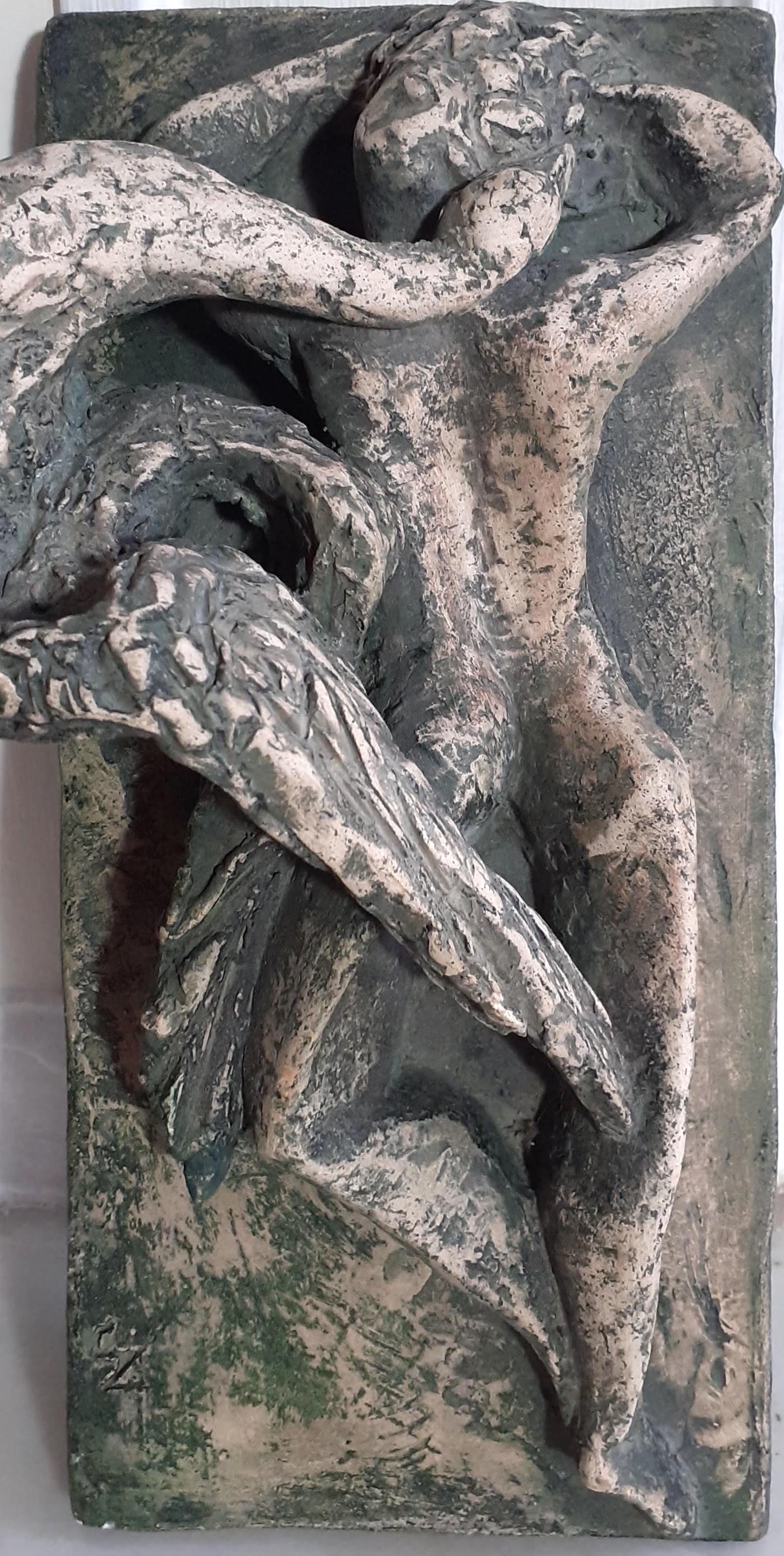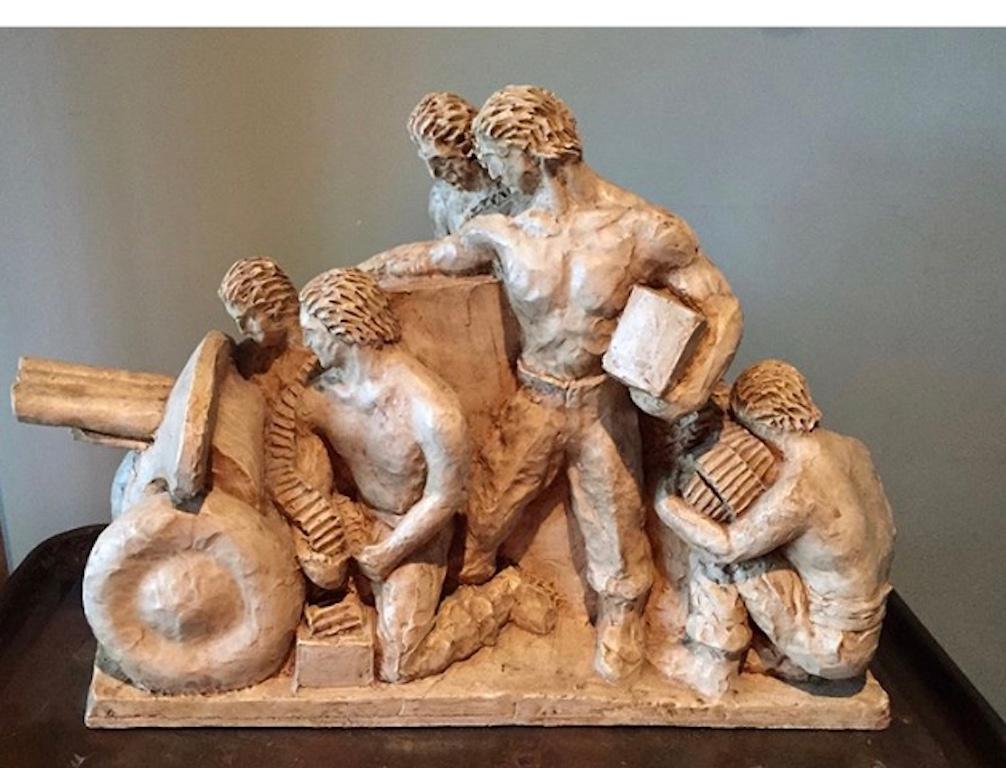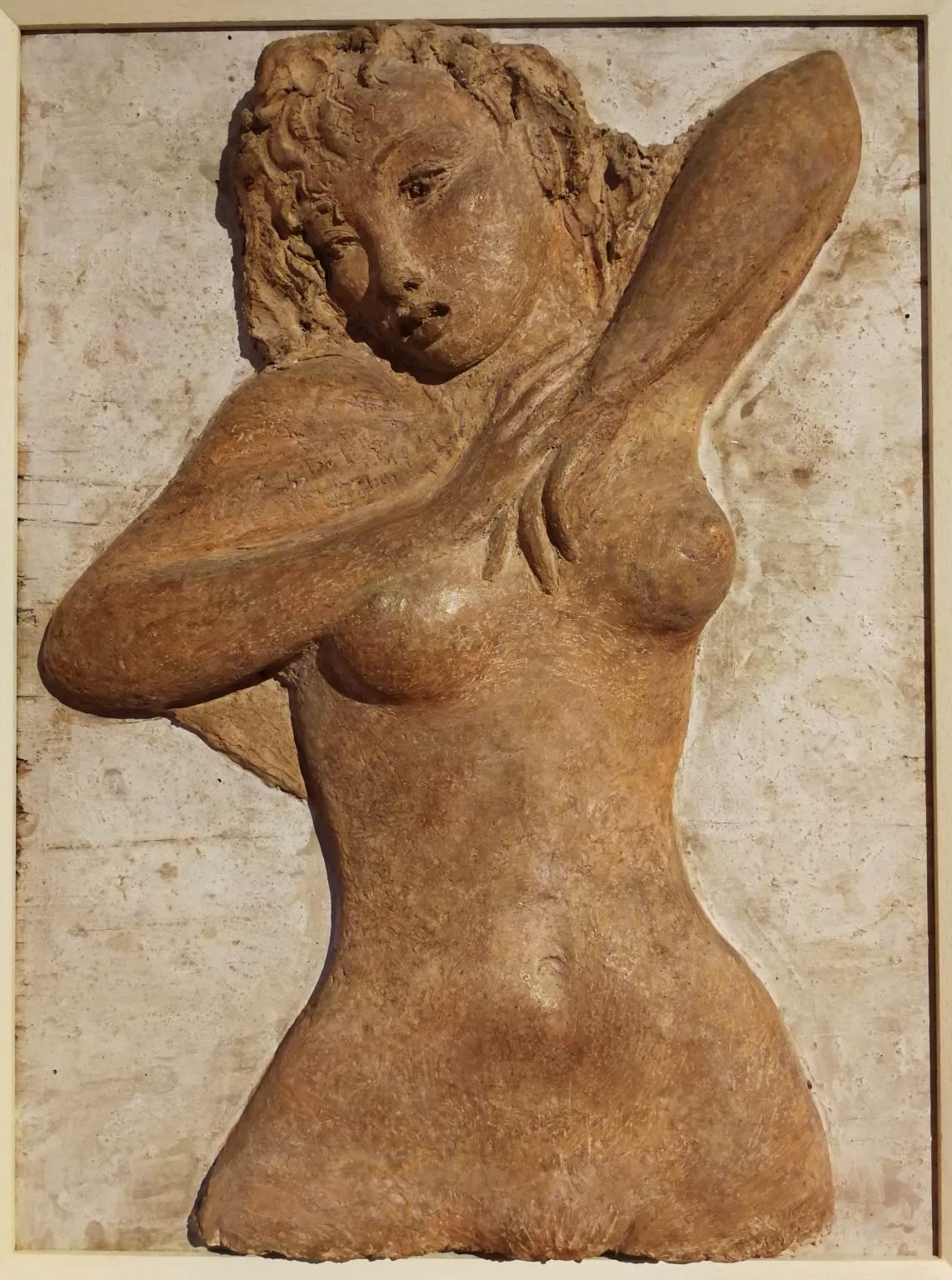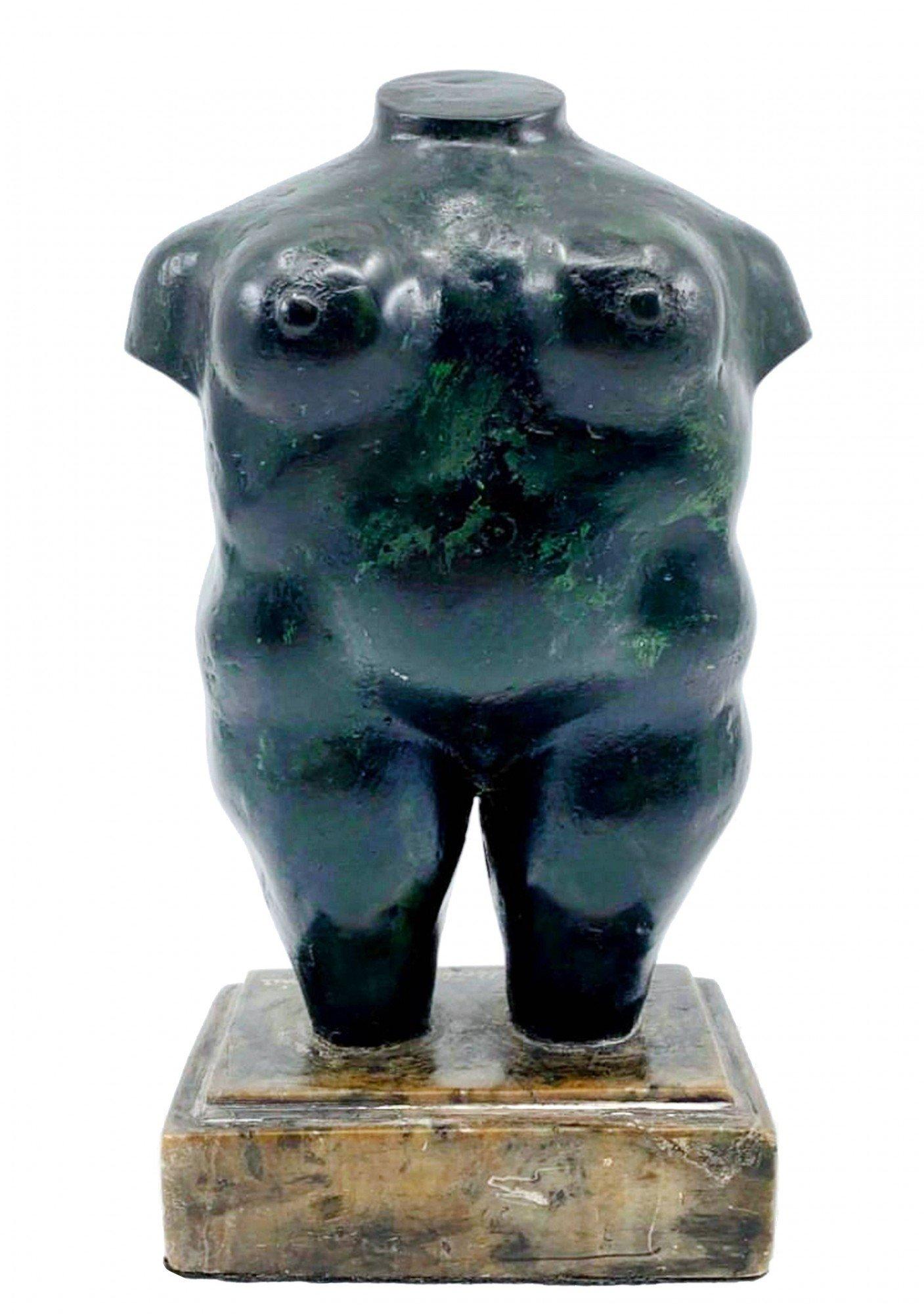Items Similar to "Symbiosis" Original Plaster Cast Sculpture by Natalie Krol
Want more images or videos?
Request additional images or videos from the seller
1 of 9
Natalie Krol"Symbiosis" Original Plaster Cast Sculpture by Natalie Krol1968
1968
About the Item
This sculpture by Natalie Krol is made of plaster with a beautiful bronze color finish. It is the cast for the bronze.
It shows a nude, pregnant woman resting. The expression on her face could almost suggest that the artist had surprised her model in her sleep, so relaxed and serene in her facial features. The curves are harmonious, with the protruding belly placed on its side, a position that pregnant women, after some months, adopt for comfort. The side of this sleeping beauty's face rests on her hand. The breast is delicately concealed by the movement given to the body by the folded arm. The long hair could also be mistaken for a veil, as in the Marian iconography of pregnant Virgins. The back is a marvel of aesthetics, with rounded buttocks, a hollowed and arched back, and the ridge of the spine appearing on a very slender body.
The art celebrates beauty, with a particular focus on the representation of women as a central theme. The exploration of shapes, contours, and the various aspects surrounding the feminine mystery became an important focus. References to motherhood abound, from devotion to the fertility goddesses to the glorification of the Virgin and Child, to expressions of maternal love and its nurturing role. Over the centuries, artists were subjected to Christian and conservative morality, resulting in a limited representation of a pivotal phase in a woman's life. This moment of transition, between no longer being a virgin and not yet being a mother, was often associated with the perception of the sinfulness of the flesh. In the 20th century, numerous works of art, both pictorial and sculptural, represented this period of a woman's life, between celebration, demands liberation, transgression, etc. Through this sculpture, navigating between the taboo of reality and the purity of the sacred, the artist has created an elegant and inclusive homage that intertwines contemporary and historical references associated with maternity.
Natalie Krol's entire lifetime has been spent creating artwork. she is a sculptor of monumental and miniature sculpture and her major claim to fame is being the first artist in the U.S.A. to cast fine art images in the stainless steel medium. In 1981, “Film Strip USA” located in Culver City, CA, was documented as the largest stainless steel sculpture built by a woman at that time.
Fifty-seven of her monumental-sized sculptures are viewed by the public daily in many different parts of the world. Twelve hundred and fifty original works are in private collections around the world. In Laguna, CA "Pageant of The Masters," her monumental-sized sculpture, “Olympic Rhythms,” was reproduced, and it was represented by a live person nightly for ten weeks. She incorporated multiple artistic uses for stainless steel within a single sculpture: casting, punching, forming, welding, and scrolling.
“Silver Tornado,” a cast stainless steel bucking bull in Prescott, AZ, is engineered to stand on its two front feet only, with no external armature. The sculpture weighs four thousand pounds. It is strong enough to support twenty human bodies at one time. In 1999, she was awarded “1999 Feature Program of The Year” out of seventeen hundred entrants by Prescott’s Community Access Channel for her creation of a thirty-minute video demonstrating the phases used during the construction of her bucking bull “Silver Tornado.” The bull is bucking on Whipple Street in front of the Yavapai Regional Medical Center.
Her lifetime has been spent teaching art classes to children and adults of all ages, conducting workshops for Art Supervisors from the Los Angeles County School Districts with twenty-two schools in each teacher's district. She created a new teaching method to convey perspective techniques for art education from kindergarten through grade twelve. She also taught sculpting and drawing classes to grades seven through twelve at the Windward School in Los Angeles, CA, and taught art classes to children aged fourteen to seventeen who are on probation after serving incarceration sentences in Prescott, Arizona.
- Creator:Natalie Krol (1928, American)
- Creation Year:1968
- Dimensions:Height: 6 in (15.24 cm)Width: 24.5 in (62.23 cm)Depth: 8.5 in (21.59 cm)
- Medium:
- Movement & Style:
- Period:
- Condition:
- Gallery Location:Pasadena, CA
- Reference Number:1stDibs: LU654313701272
About the Seller
5.0
Vetted Seller
These experienced sellers undergo a comprehensive evaluation by our team of in-house experts.
Established in 1999
1stDibs seller since 2017
50 sales on 1stDibs
Typical response time: 9 hours
- ShippingRetrieving quote...Ships From: Pasadena, CA
- Return PolicyA return for this item may be initiated within 3 days of delivery.
More From This SellerView All
- "The Nose" White Modern Plaster Sculpture on a Lucite and Black MarbleLocated in Pasadena, CAThis whimsical sculpture features a white plaster nose on a black marble base sitting on a Lucite one. The overall impression is elegant, because of the ...Category
1990s Modern Figurative Sculptures
MaterialsMarble
- "Sharon" Life-size Brass Sculpture by Robert Lee MorrisLocated in Pasadena, CAIn front of Robert Lee Morris's Beverly Hills store in 1993 stood this unique life-size brass sculpture of a nude woman with a bob cut, dressed only with luxurious jewelry. The sculp...Category
1990s American Modern Figurative Sculptures
MaterialsBrass
- Lucite Flower by Herb Elsky- 1983Located in Pasadena, CAThis rare Lucite resin sculpture, bearing the signature of Herb Elsky and dated 1983 on its base, portrays a flower and its stem intricately carved within two acrylic blocks joined together. It could be a phantasmal sunflower in the color of crystal. The light passes through, and flows through the flower, the shape of its head opening to the sky, its central bud, the back of its petals embellished by veins, and its foot on which fine stem details are engraved. The back of the flower boasts a rougher texture. Depending on the angle of view, the different sources of light, sun, or electrical light the flower no longer gives itself only in this transparency close to crystal but becomes tinged with yellows, or red like the sofa behind it. It is fascinating! Herb Elsky is an artist who, for several decades specialized in abstract visual art, but in more recent years combining sight and sound...Category
Late 20th Century Figurative Sculptures
MaterialsLucite
- Brutalist Wood SculptureLocated in Pasadena, CAFrom the primal landscapes of our world grow the materials that fuel our creativity - a phenomenon echoed in the creation of this brutalist sculpture. We stand with an art piece who...Category
Late 20th Century Constructivist Figurative Sculptures
MaterialsWalnut
- "Astral Perspective" Mixed-Media Blue-Grey and Purple AbstractLocated in Pasadena, CAThis square-framed abstract artwork, textured with blue-grey and purple hues, features an illegible signature and is dated 1985 in the right co...Category
Late 20th Century Abstract Abstract Paintings
MaterialsAcrylic, Plaster, Plywood, Mixed Media
- Bronze Sculpture of a Mother with Three Children by Sy RosenwasserBy Seymour RosenwasserLocated in Pasadena, CAThis original sculpture by Sy Rosenwasser features a loving and embracing mother and her three children. The artwork sits on a black swivel marble square. It is signed and dated 1997. I took many close-up pictures of the sculpture that show the patina of the bronze with the different tones. The marble as well has been chosen for its unusual and interesting structure: black with little white spots Rosenwasser was born in 1925. Her primary theme was the relationship of basic structure to life forms. She passed away in 2012. Her work may be viewed in many public and private collections including the Hyatt Regency in Hawaii, the Bonaventure Hotel in Los Angeles, the Rolex Company...Category
20th Century Modern Sculptures
MaterialsMarble, Bronze
You May Also Like
- Leda and the Swan modernist mid century sculpture by French woman artistLocated in Norwich, GBA unique piece: a hand modelled sculpture by French artist Jeannine Nathan (b.1924). Working in Paris, Jeannine was able to visit Picasso’s studio, and was impressed by the Master’s ...Category
1960s Modern Figurative Sculptures
MaterialsPlaster
- Industrial Machine Age American Scene WPA Mid 20th Century 1939 SF World's FairLocated in New York, NYIndustrial Machine Age American Scene WPA Mid 20th Century 1939 SF World's Fair HAIG PATIGIAN (American/Armenian, 1876-1950) Aeronautics Pediments Two Plaster Casts, c. 1930s each 13.25 x 14.75 x 6 inches It's possible these moquettes were created for the 1939 World's Fair, the Golden Gate International Exhibition in San Francisco. Provenance: Private Collection of Lois M. Wright, Author of "A Catalogue of the Life Works of Haig Patigian, San Francisco Sculptor, 1876-1950),” 1967 Loan to Oakland Museum of California (Oakland, CA) BIO Haig Patigian is noted for his classical works, which are especially numerous in public venues in San Francisco, California. Patigian was born in Van, Armenia, which at that time was under Turkish rule. Haig was the son of Avedis and Marine Patigian, both teachers in the American Mission School there. He and his older brother showed an aptitude for art early on and were encouraged by their parents. Their father himself had taken up the new hobby of photography. The 1880s were harsh times, however, for many Armenians under an oppressive rule by the Turkish government. Many people were fleeing to the safety of the United States. Suspicious Turkish authorities accused his father of photographing city structures for the Russian government, and in 1888 he fled for his life to America. Haigs father made his way to Fresno, California, and began life anew as a ranch hand. Within two years he sent for his wife, as well as Haig, his three sisters and brother, and in 1891 the Patigians made the journey from Armenia. Haigs father, an industrious man, worked on various farms, and eventually bought his own ranch and vineyard. It was among fertile farmland of Fresno that Haig grew up. Young Haigs education consisted of teachings by his parents and by intermittent attendance in public schools. Although he had dreams of becoming an artist, he did not have the opportunity for formal study of art, and began working long days in the vineyards around Fresno. At age seventeen, Haig made a step towards his dreams and apprenticed himself to learn the trade of sign painting. In his spare time he nurtured his interest in art by painting nature and life scenes with watercolors and oil paints. When his sign-painting mentor left Fresno, Haig opened his own shop and made a name for himself in the town. San Francisco, in the meantime, had been attracting artists since the Gold Rush and had become a thriving art center. Within a few years, Haig had put aside several hundred dollars to move to San Francisco, joining his brother who was already working there as an illustrator. In 1899, when he was twenty-three, Haig had saved enough money to enroll at the Mark Hopkins Art Institute in San Francisco. Like many aspiring artists of his time, Patigian supported himself by working as a staff artist in the art department of a local newspaper, and in the winter of 1900, nearing his 24th birthday, Haig began work for the San Francisco Bulletin, producing cartoons, black and white illustrations, as well as watercolors. In 1902 tragedy struck Haig and his family. His 29-year-old brother died of pneumonia, and then his frail mother died a short time later. Five months more saw his youngest sister, just out of high school, die too. Saddened and depressed, Haig moved out of the studio he had shared with his brother, and into a dilapidated studio in a poor section of town. During this time of sadness, Haig fed a growing interest in sculpture. In 1904 Haig created what he later called his "first finished piece in sculpture". The work, called "The Unquiet Soul", depicted a man thrown back against a rock while waves lash at his feet. The body was tense and twisted, with one hand, in Haig's own words, "searchingly leaning and clutching the rock, while the other masks his troubled head". The Press Club of San Francisco, which Haig had joined in 1901, put "The Unquiet Soul" on exhibition and local headlines proclaimed "Local Newspaper Artist Embraces Sculptor's Art", and "First Work Predicts Brilliant Future". With the support of friends and community acclaim, the young illustrator left his newspaper job and became a professional sculptor. The path of his new career was not easy though. Haig had never made much money working for the newspaper and his father needed help with growing debt from funeral expenses and business problems. From time to time Haig sold some artwork, but also occasionally borrowed from friends to pay the rent. He was the classic 'starving artist'. In the spring of 1905 a white-bearded 81-year-old stranger knocked on Haig's door. It was George Zehndner, from Arcata, California. Zehndner had been born in Bavaria, Germany in 1824, the son of a farmer. In 1849 he had come to America looking for prosperity, settling in Indiana, where he worked on a farm and learned English. He found his way to the West Coast in 1852. Penniless, he worked in various jobs from San Francisco to Sacramento, then found some luck working in the gold fields of Weaverville in Trinity County, and eventually moving to a farm on 188 acres near Arcata. In his 77th year in May of 1901, Zahndner had taken a trip to San Jose, where he stood in a crowd to see a man he thought much of, President William McKinley. McKinley was popular as 'the first modern president' partially because he realized going out to meet the common person increased his support. In September of that year, however, an anarchist assassinated the president while he stood in a receiving line at the Pan-American Exhibition in Buffalo, New York. Soon after, the city of San Jose erected a statue of the slain president in St. James Park. Zehndner took a second trip to San Jose where he visited the McKinley monument. Touched, Zehndner decided that, no matter the cost, his town of Arcata too would memorialize McKinley. George Zehndner had read about Haig in a newspaper article and asked if Patigian would create a heroic statue of the late President McKinley for Arcata. When asked how much it would cost, Haig responded, despite his borderline poverty, with the fabulous sum of $15,000. Zehndner agreed. The President was to be portrayed standing, wearing an overcoat, with his feet planted squarely on the ground. In the finished statue, one hand is held out before him in a typical posture of speaking, with the other hand holding the speech as his side. The 9-foot statue...Category
1930s American Modern Figurative Sculptures
MaterialsPlaster
- 2 Sculptures: "The Power" & "The Glory" WPA Depression WWII era mid 20th centuryBy Agnes YarnallLocated in New York, NY2 Sculptures: "The Power" & "The Glory" WPA Depression WWII era mid 20th century by Agnes Yarnall circa 1940s. Sculptor, painter, poet and artistic historian, Agnes Yarnall has, since the age of six been breathing life into her art. Renowned as a sculptor, whose commissioned portrayals of contemporary celebrities are prized. She has sculpted Judith Anderson, Edna St. Vincent Millay, Carl Sandburg...Category
1940s American Modern Figurative Sculptures
MaterialsPlaster
- "Pioneer Family" WPA American Modernism Plaster Maquette Realism 20th CenturyBy William ZorachLocated in New York, NY"Pioneer Family," 23 1/2 x 16 1/4 x 10 3/4 inPlaster. c. 1927. Unsigned. Realism The Smithsonian has a cast of this sculpture in its collection. Pictured on the cover of “The Sculpt...Category
1920s American Modern Figurative Sculptures
MaterialsPlaster
- Signed Bruno Innocenti Female Nude Sculpture Relief 20 century plaster woodBy Bruno InnocentiLocated in Florence, ITThe bass-relief is made of plaster painted with the warm color tone of the earth in order to represent terracotta. The subject is a juvenile girl, as we can see by the tenderness and...Category
Mid-20th Century Post-War Nude Sculptures
MaterialsTerracotta, Plaster, Wood Panel
- 20th Century Nude Torso, boteroesque sculpture, contemporary Colombian artistLocated in Beachwood, OHAlberto Echevarria (Colombian, 20th Century) Nude Torso Cast plaster with patina, on carved marble base Signed on base 8 in. h. x 4 in. w. x 2.75 in. d. Inscribed “Made in Medellin (...Category
20th Century Contemporary Nude Sculptures
MaterialsMarble





